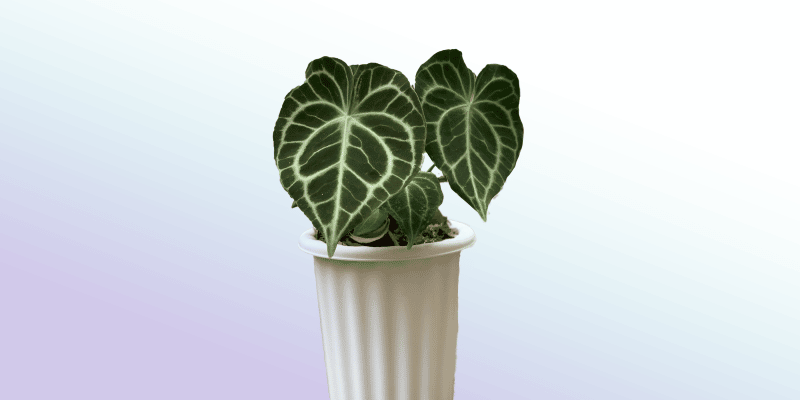With large, velvety heart-shaped leaves that glisten and striking white veins, Anthurium crystallinum makes a strong visual first impression.
But when first impressions end we’re left with a wonderful plant that rewards our care with beautiful flower growth and unique air filtration properties.
In this guide, we’ll explore the history of Anthurium crystallinum, how to take care of it, and how to propagate more for your friends and family. We’ll also cover the most common issues you’ll have and how to solve them, so let’s dig in!
Table of Contents
Anthurium Crystallinum Care Guide
History, habitat, and characteristics
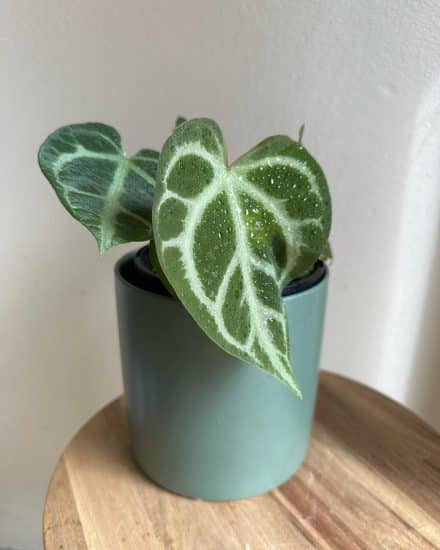
Anthurium crystallinum is a tropical plant with unique velvety leaves that traces its roots back to the rainforests of South America and is considered to be the jewel of the Anthurium family.
Now seen more often as a houseplant, it was first discovered in Colombia in 1876 by the renowned French Botanist, Eduard Andre. As Mr. Andre traveled, his discoveries of calla lilies and orchids introduced the world to new and exotic tropical plants, including this beautiful large-leafed plant from the anthurium genus (which contains over 1000 species, including the Anthurium clarinervium).
Let’s talk about appearance. Anthurium crystallinum’s leaves are uniquely heart-shaped and attractively shimmer with light. Its dark green leaves are covered in a highly reflective, almost metallic sheen and white veins.
Not only does this beautiful tropical plant add a bit of green beauty to your home, but it also has remarkable air-purifying benefits. NASA identified the Anthurium species an effective air-purifying plant due to its ability to rid the air of formaldehyde, ammonia, xylene and toluene.
We’ll cover varieties real quick, but then let’s fully get into our Anthurium crystallinum care guide and how to grow this lovely plant.
Varieties
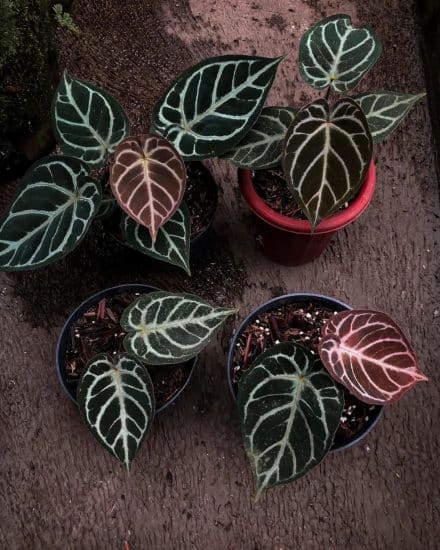
Anthurium veitchii, is sometimes mistaken for Anthurium crystallinum. Anthurium veitchii’s leaves have a more pronounced ridge, are more elongated and the veins are less prominent.
Both varieties have stalks that terminate in an inflorescence in the center of the plant with a single spike of flowers that give off a unique sweet and spicy smell.
Light
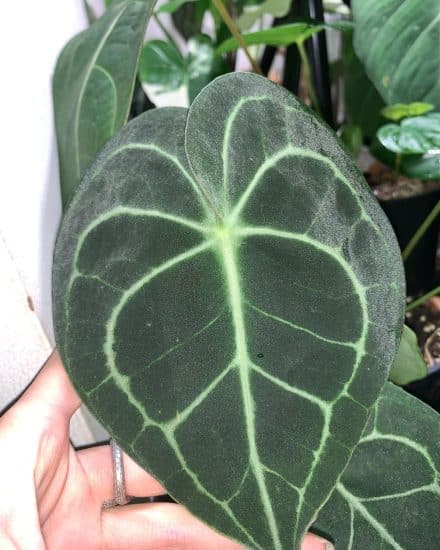
The Anthurium crystallinum grows best in bright, indirect light but should not be exposed to too much direct sunlight, as it can easily burn the leaves of the plant.
Natural sunlight is best: I recommend an east or north-facing window, no more than 4-5 feet away. To reduce the risk of sunburn you can add a curtain if the window is especially sunny.
When the Anthurium crystallinum doesn’t receive enough light you’ll start to notice smaller leaves with yellowing tips. If your plant is getting too much light you might notice the leaves turning brown and crispy.
Lighting tips and summary:
- Too little light: crystal anthurium will become leggy and its leaves will take on a darker shade of green.
- Too much light, the leaves may bleach, with yellow fading to brown.
- If you live far from the equator you may need to supplement with artificial lighting during the winter months when natural light is often in shorter supply.
Water
As you probably know, Anthurium crystallinum hails from the humid rainforest and it loves to have the occasional deep drink. This can be a challenge as there is a balance to be struck between overwatering and underwatering which are each detrimental in their own ways.
When watering Anthurium crystallinum make sure to soak the soil to a depth of 4-6 inches (10-15 cm) to ensure that all the roots are reached. Excess water can drain out of the pot after it’s been watered.
Watering tips:
- Use room temperature water and slowly and deeply water at the base of the plant, avoiding any leaves. You’ll want to feel the top inch or two of the soil. If it’s dry, give it a drink.
- Underwatering can be identified by browning and curling of the edges of leaves while overwatering can present wilting, yellowed leaves and discoloration of the roots. If you’ve overwatered your Anthurium crystallinum remove it from its pot, discard the old soil, and repot with fresh soil in order to start its recovery.
- Use filtered or purified water if your tap water isn’t suitable to avoid yellow discoloration and leaf burns.
Temperature and humidity
Welcome to your own personal tropical jungle: your Anthurium crystallinum! To ensure that your indoor paradise thrives, you’ll have to create the ideal conditions for it to flourish.
Temperature and humidity will be your two main tools in keeping your Anthurium crystallinum looking lush and vibrant.
Temperature: According to research conducted by Silva et al (2020), the optimal temperature range for Anthurium crystallinum lies between 68 and 86ºF (20-30ºC). Leaf damage or stunted growth may occur if temperatures fall below 65ºF (18ºC). It is also important to keep the plant away from direct drafts, as these can cause unexpected fluctuations in temperature which could be detrimental to its health.
Humidity: Humidity between 50-70% is ideal for Anthurium crystallinum. Keeping the plant in an environment this humid can be difficult, but there are a few methods to help achieve it. Placing anthurium crystallinum on a pebble tray, filled with room-temperature water, is an effective way of raising the local humidity. Experiments conducted found that the growth rate of plants is significantly increased when they are within their ideal humidity zone.
In summary:
- Anthurium crystallinum prefers warm temperatures between 70-80°F (21-27°C) with occasional dips below 60°F tolerated.
- Humidity levels of 50-70% are ideal; mist leaves regularly, place plants together, or set up a pebble tray with water to maintain humidity.
- Avoid dry, heated areas of the home like radiators, and be mindful of air circulation to prevent fungal diseases.
Soil and planting
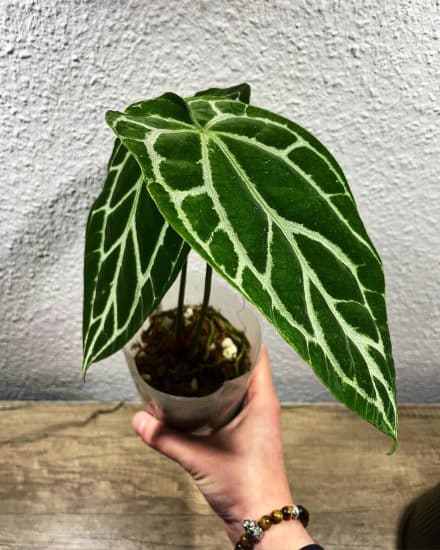
The crystal anthurium plant, like other tropical plants, does best with a light potting mix that still provides good drainage. You can achieve this with peat moss, vermiculite, and perlite. If you do happen to have access to porous brick, LECA, or nut shells, these can also add aeration and drainage. You can layer them at the bottom of a pot to help with water retention.
If you acquired this plant in unknown potting soil, this is a great opportunity to repot your Anthurium crystallinum. Let’s go over some of the best components for a light potting soil mixture that will still retain water. You can add these to any potting soil, including what it came in.
- Sphagnum Moss: Aeration, water retention, and pockets of air for the plant to thrive.
- Perlite: Drainage and room for root growth.
- Coconut Coir: Water retention, and aeration.
- Charcoal: Organic matter and nutrients.
You’ll aim for a pH between 6-7.5 and can order a soil test kit to use at home if you want, but I’ve never actually known someone to need these if using standard potting soil and the above modifiers.
Fertilizing the plant with a balanced liquid fertilizer applied at 50% of its recommended strength every month during the spring and summer months is optional. It is important to note that over-fertilizing will often result in burnt plant leaves from most chemical fertilizers, especially if undiluted. Indoor plants usually don’t need liquid fertilizers, but if you do use one consider a slow-release fertilizer in moist soil.
That’s it for the main part of our Anthurium crystallinum care guide. We’ll now cover propagating Anthurium crystallinum and how growing more outside of its natural environment is actually pretty easy.
Propagation guide
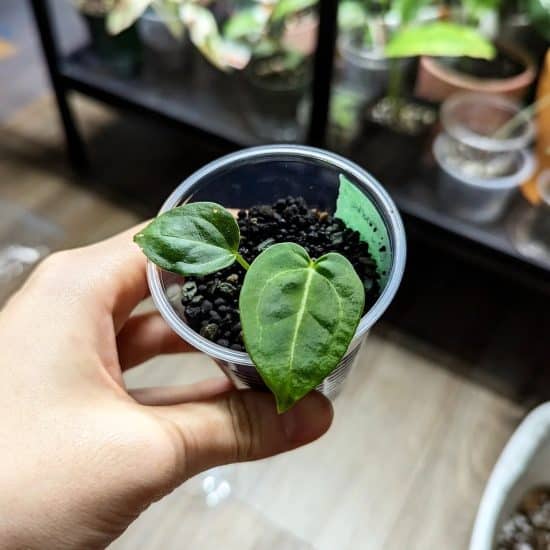
Propagating an Anthurium Crystallinum is the perfect way to distribute a few plants to your friends or make your home a bit lusher. To propagate Anthurium crystallinum there are a few main techniques that all involve stem cuttings: water propagation, moss propagation, or soil propagation.
Water propagation is the simplest method, as it involves taking stem cuttings from the mother plant and placing them in a water bowl. This method creates an optimum environment for quick root growth and offers control over water levels, but it does require regular water replacement.
Sphagnum moss propagation is also pretty easy, as cuttings are placed in moistened sphagnum moss. This method is slightly better for environmental control than soil but requires frequent maintenance to ensure the moss is kept moist, not wet.
Soil propagation requires a little more labor and care, as you’ll need to prepare a potting mix before placing the cuttings in the soil. This method offers more control over the environment and roots take longer to form, but can be transferred to their own pot once established and usually experience less shock.
Propagating crystal anthurium with stem cuttings involves finding a section of stem with aerial roots and nodes (located at the base). Cut off an inch or so below the node, then plant it in either water or soil. With soil, you need to make sure the node section is completely buried. With water, it should be submerged. It should take a month for you to notice roots forming, and you can speed this process up by applying a rooting hormone.
Alternatively, division is the process of splitting mature plants into two or more child plants, each with its own root system.
Start by delicately removing the whole plant from its container and look for pieces with their own root systems. Make sure each piece has at least one leaf.
Now it’s time to separate your plants. If you have trouble, you can use a pair of sterilized sheers to cut them apart. Now plant each piece into its own container, add water, and wait a few weeks. The new plants may slow their growth for a while, so it’s best to divide during the spring and summer months.
Tips:
- Ensure the divided pieces are planted in containers appropriate for their size.
- Look for aerial nodes and consider using a rooting hormone with stem cuttings.
- Propagate Anthurium crystallinum during its natural growing season, which typically starts in early spring.
Common issues
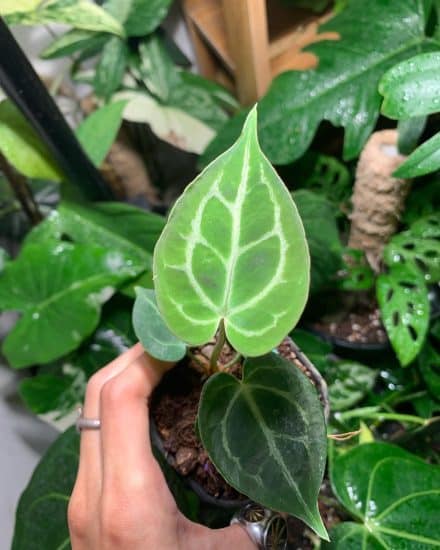
Giving your Anthurium crystallinum the care it needs is actually pretty easy, but let’s highlight a few areas of concern so you can catch these issues early.
The closer we get to the original environment of an exotic plant the easier it will be to keep it a healthy plant, without living in a sauana of course.
The most common Anthurium crystallinum issues you might notice:
- Yellow leaves: Crystal anthurium, like many houseplants, doesn’t tolerate direct sunlight. Like at all. If the edges of the leaves are turning yellow, this is a sure sign it’s getting too much light and you need to relocate it or add a curtain to your window.
- Dropping/drooping leaves: Usually an issue with water. Check if the soil is damp and if it’s not, give your plant a good drink. In some cases, you may find the plant dropping leaves after sudden temperature changes. If you tend to have your AC on high or there is a draft near the plant from a window, this is a likely cause. Move your Anthurium crystallinum away and make sure it stays at an stable temperature.
Another way to think about plant care is by exploring the most common causes of issues and making sure none of these apply to you.
Excessive Watering
Excessive watering is a leading cause of fungal diseases in Anthurium crystallinum. Water-logged soil can lead to root rot, leaf spots, and discoloration of the leaves. To prevent this, be sure to check the soil before watering – if you tend to keep the soil moist be comfortable with the soil getting a bit dry. Also make sure you’re watering at the base, as too much moisture can promote bacterial growth on leaves. If you still have issues with wet soil, it’s time to examine the potting mix and drainage.
Low Humidity
Anthurium crystallinum is susceptible to brown leaf tips, dead ends, and slow growth when low humidity is present. Aim to keep the surrounding environment as humid as possible (without going overboard) and make sure it has access to some shade during the hottest parts of the day.
Direct Sun
Too much direct light can cause damage to the delicate leaves and fine photosynthetic machinery of Anthurium crystallinum. Make sure to place the plant out of direct sunlight, and provide ample shade during the hottest days of the year, mimicking the natural habitat for this relatively slow grower.
By showing your anthurium a little extra TLC, your plant will remain as healthy as the day you brought it home. Just remember: prevention is better than cure, but if you do find yourself with any of these common issues, don’t worry, they’re common for a reason!
Diseases and pests
Often we’ll find an issue with our plant, resolve it with proper care, and then notice secondary issues in the weeks that follow. A weakened plant or one that’s excessively watered can often develop new issues that we’ll need to resolve even when the underlying causes are taken care of.
Let’s go through a few of these and how to resolve them.
Pests: Aphids, spider mites, and mealybugs are all common pests of Anthurium crystallinum. To avoid them, use insecticidal soap to spray the entire plant if you notice them. Small colonies of pests can be removed with alcohol or neem oil. Lastly, a damp cloth can be used to wipe down the leaves regularly to prevent pest infestations. If you spray with water, make it cold as this works the best!
Root Rot: Root rot is a common issue for Anthurium Crystallinum since they require well-draining soil. Signs of root rot include wilting leaves or discoloration. If you suspect your plant is affected by root rot, check to see if the roots look mushy or discolored. If so: cut them off. Repot with well-draining soil and make sure to water the base of the plant and really let the soil dry out between waterings.
Fungal Spots: Fungal spots can be caused by providing your plant with too much shade, or by high humidity. To avoid these, provide your plant with plenty of bright, indirect light and make sure to water the base of the plant and avoid getting the leaves wet.
Most importantly, with any of these issues, try to isolate your plant away from others as you deal with it. The last thing you want is for these problems to start spreading.
Conclusion
You should now feel fully capable of taking care of your crystal anthurium plant.
Quick summary:
- Provide this plant with an airy potting mix (peat moss is highly recommended).
- Pay attention to humidity and group plants together or add a water tray, especially in the winter.
- Indirect light is key.
- Liquid fertilizers are usually not required, and look out for burn marks on the leaf margins or browning tips.
If you found this article helpful, feel free to share it with a friend along with a cutting from your Anthurium crystallinum! If you have suggestions, feedback, or any additional questions you can always reach out to us.
FAQ
Is Anthurium crystallinum hard to care for?
Not at all. Most of the plants in this genus are pretty tolerant to indoor plant life, especially if you keep an eye on soil moisture and direct sun.
What is the most rare Anthurium?
Crystal anthurium used to be more rare in the past, but more recently I would say Shibori anthurium is a much rarer cousin.
Is Anthurium crystallinum an indoor plant?
It is. Though Anthurium crystallinum looks at home with other plants at your local nursery, it originates from the tropical rainforests of Columbia and Ecuador. When we call it an indoor plant, we mean that with proper care that crystal anthurium will thrive, even outside its natural habitat of Central and South America.
Can you grow Anthurium from a cutting?
You can, this is a great way to grow your crystal anthurium, but you can also look for newly divided plants at a local garden center. Different plants within the species have different qualities, so if you like a friend’s make sure to ask for a cutting!
How do you make Anthurium crystallinum grow faster?
The key growth ingredients are: light, water, and soil. If you optimize these in a humid environment, this plant will thrive. Remember that fast growth isn’t always the best for physical appearance or long-term plant quality, so we encourage you to take your time.
How do you propagate Anthurium plants?
We have a complete propagation guide above, and recommend taking a cutting to propagate in water or soil.

